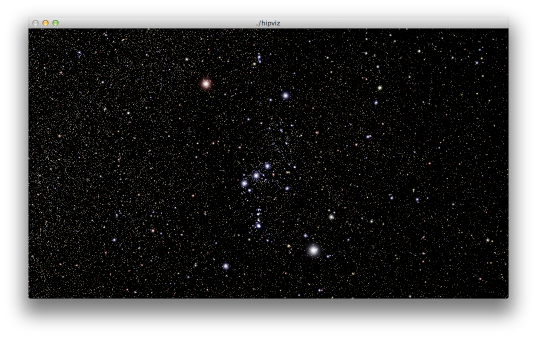Hippo provides a spatial index for 3D star catalogs enabling high-performance neighborhood and visibility determination. It includes functions to ingest raw Hipparcos data and serialize it to a binary RIFF file. An example application demonstrates the real-time 3D visualization of this data.
Hippo is implemented as a simple C module:
Each star is stored with a very limited number of fields, chosen primarily for simple star field rendering. The pos field gives the 3D position of the star in light years. The mag gives the B-band and V-band magnitude of the star.
struct star
{
float pos[3];
float mag[2];
};
typedef struct star star;
These fields suffice to compute the apparent magnitude of a star (V - 0.09 (B - V)), the absolute magnitude (given its position), and thus the apparent magnitude at any point in space. Additionally, the color index may be computed (0.85 (B - V)) and used to determine the spectral type and apparent color of each star.
A star catalog and its spatial index is represented using an opaque hippo structure.
typedef struct hippo hippo;
There are several functions that operate upon this structure.
-
hippo *hippo_read(const char *filename)Read a star catalog in RIFF format from the file named
filename. Return ahippostructure, orNULLon failure. For efficiency, this function memory-maps the RIFF, so it will remain open until freed. -
int hippo_write(hippo *H, const char *filename)Write a star catalog in RIFF format to the file name
filename. Return 0 on failure. -
void hippo_free(hippo *H)Release a
hippostructure, free all memory that it uses, and close any open RIFF file. -
const star *hippo_data(const hippo *H)Return the full array of stars in the catalog.
-
uint32_t hippo_size(const hippo *H)Return the number of stars in the catalog.
The following functions enable efficient query of a star catalog.
-
void hippo_seek(const hippo *H, const float *v, int c, hippo_seek_fn fn)Call the given call-back function
fnwith each list of stars that falls within the volume bounded by the array ofcplanes atv. Each plane is given in the form of the four parameters (a, b, c, d) of the plane equation ax + by + cz + d = 0, sovis assumed to have length4 * c.In all likelihood,
fnwill be called many times for each invocation ofhippo_seek. Depending upon the granualarity of the spatial index (the depth of subdivision specified when the catalog was ingested) there is a small possibility of stars not within the specified volume appearing in the returned lists. However there is no possibility of a star within the specified volume not appearing in at least one list.The call-back function has the following signature. The argument
vwill be a pointer to an array of stars, andcwill give the number of stars in that array. This array will be a subset of the full array given byhippo_data.typedef void (*hippo_seek_fn)(const star *v, uint32_t c);The
hipviz.cppexample demonstrates the use thehippo_seekfor determining star visibility in a real-time 3D star catalog renderer. -
void hippo_view_bound(float *v, const float *M)Generate a set of six planes corresponding to the bounds of the view volume defined by the 4 × 4 model-view-projection matrix
M. The arrayvmust accommodate 24 floating point values. This is a convenience function useful for determining the set of currently visible stars. -
void hippo_cube_bound(float *v, const float *p, float d)Generate a set of six planes corresponding to the bounds of the cubic volume centered at the 3D position
p, extendingdlight years in all directions. The arrayvmust accommodate 24 floating point values. This is a convenience function useful for determining the set of stars neighboring any point in space.
The following two functions enable the ingestion of raw stellar data from archival sources. These functions are called by the hipgen utility. They are not generally needed by the end user, as RIFF files of both Hipparcos and Tycho-2 are made available here.
-
hippo *hippo_read_hip(const char *filename, uint32_t d)Read a star catalog in Hipparcos main catalog format from the file named
filename. Generate a spatial index with depthd. ReturnNULLon failure. The Strasbourg Astronomical Data Center provides the complete Hipparcos catalog in the gzipped filehip_main.dathere. -
hippo *hippo_read_tyc(const char *filename, uint32_t d)Read a star catalog in Tycho-2 main catalog format from the file named
filename. Generate a spatial index with depthd. ReturnNULLon failure. Because Tycho-2 records do not include trigonometric parallax, the distance to these stars is not known and the their 3D position cannot be calculated. Instead, they are positioned at a distance of 10 parsecs from the origin, where absolute magnitude equals apparent magnitude. The Strasbourg Astronomical Data Center provides the complete Tycho-2 catalog in the segmented gzipped filetyc2.dathere.
